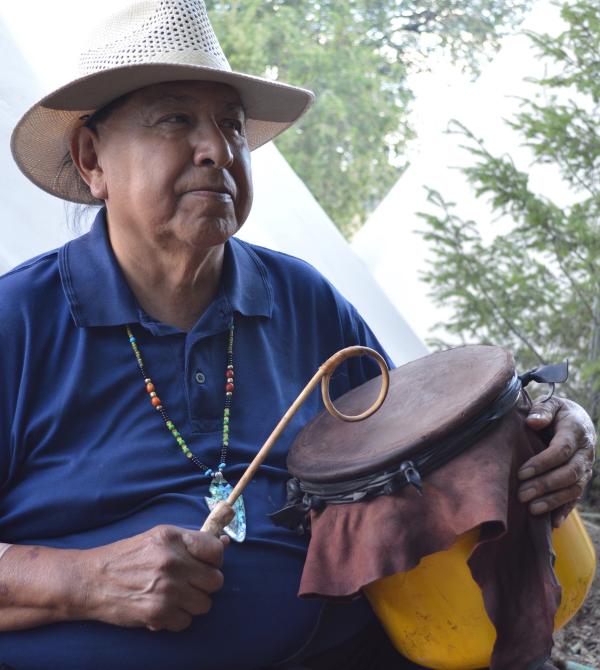Cochise’s Living Descendants Meet Generational Trauma With Pride

Their Apache ancestors were chased, hunted and herded into history. Shaped by decades of war, Geronimo, Cochise, Victorio, Lozen and Mangas Coloradas (and those they ran with) cultivated a genius for survival so their descendants could live on.
Cochise (c. 1805 – June 8, 1874) was a reluctant Apache warrior, but a persistent one who survived the Battle of Apache Pass to fight on another decade. His descendants, who live on reservation lands granted after the Indian Wars in Mescalero, New Mexico, are inheritors of that doggedness. By vocation and avocation they continue their ancestor’s fight for Apache survival.
Freddie Kaydahzinne, tribal cultural museum curator, conjures a picture of Cochise as a six-foot tall, wise and kindhearted man respected and honored by the Chiricahua people—“a medicine man who received his powers from the Creator.”
“When the white man came and we were subjected to colonization and miscegenation, Cochise was able to keep his people together so they would not lose their identity,” Freddie explained. “He saw that the white man wanted our Apache lands because of the mineral resources—the gold and silver.”
Freddie described a gentle wood carver forced to take up arms, a warrior holding a spear in one hand and bow and arrow in the other against cannons and rifles.
“The wars became very bloody, but one thing that our people had was the Creator there to help them every time they asked,” he said.
Some of the defense tactics remain in the realm of mystery. “Twenty people would spread out 30 to 40 yards apart and then the enemy would ride through them,” he explained. “Our people would turn into rocks, yucca plants; and our enemies, they would say they didn’t see no Apaches.”
He only learned of his familial connection to Cochise in adulthood. “When I was a little boy I used to be thrilled and excited to see shows with cowboys and Indians on our black and white TV. They would talk about this chief, Cochise, that’s how I learned to know his name,” he recalled. “Later on, when I started to get deep into my Apache way of life—the songs, prayers, ceremonies, medicine—I started to learn about my ancestors. It thrilled my heart that I came from a great blood line.”
Like Freddie, the historical exhibits at the Mescalero Apache Cultural Center & Museum pull no punches. Having daily reminders of the atrocities—“the genocidal annihilation of my people” as Freddie terms it—might make another man bitter.
“It makes me angry, but I put everything in God’s hands. I don’t have a revengeful heart, I don’t hate anybody for that. But I am proud that our people were able to defend us.”
Hazel Spottedbird’s grandfather Christian Naiche Jr., grandson to Cochise, was born a prisoner of war and lived the first 13 years of his life in the Apache prison camps of the Southeast.
“Grandpa didn’t say a whole lot to us about his early life as a child prisoner, because we were still young ourselves,” Hazel explained. But he was among those Apache elders who provided oral histories to Eve Ball, whose papers are archived in the C.L. Sonnichsen Special Collections Department at the University of Texas in El Paso.
“I am a very proud Chiricahua Apache because of those names Naiche and Cochise,” she declared. “My grandpa lived without fear, my mother also; she would not be told what to do, she had her own mind. I feel like I’m like that now, out of my three sisters I’m the one who’s out there: I dance, participate, I’m not afraid.”
Hazel has served on the tribal council, worked in a substance abuse program, has been an accountant and is a judge. But she’s craving something very specific now.
“I’m at the age where I want to sit down with people and talk to them,” she confessed. “We lived in two rooms with no running water, no electricity, no cook stove. We carried water from the springs; I’ve seen my mom carry wood in a blanket to keep us warm. I’m not ashamed to speak up.”
Having experienced hardship, Hazel feels she can be of service to people who are going through their own difficulties.
“I want to tell them whatever their problems are, let’s take care of it, let’s fix it, let me help,” she said.
But that service will largely have to wait until after she retires from her judgeship. Given her ancestry, she’s understandably loathe to lock people up. “If I absolutely have to incarcerate, I do, but my preference is always treatment,” she admitted. “I think the system should try to help people instead of punishing them.”
Recently she was asked to be a cultural counselor at the Albuquerque Detention Center for Youth where some of the Native inmates identify as Apache. “I met with some of the kids,” she said. “We talked about the strength of our Apache ways. I want to share it with everyone.”
RELATED: Meet the Geronimos: Descendants Talk About Living With the Legacy
Keep an eye on ICTMN.com for stories about descendants of Victorio, Lozen and Mangas Coloradas.
Read more at http://indiancountrytodaymedianetwork.com/2016/08/31/cochises-living-descendants-meet-generational-trauma-pride-165578